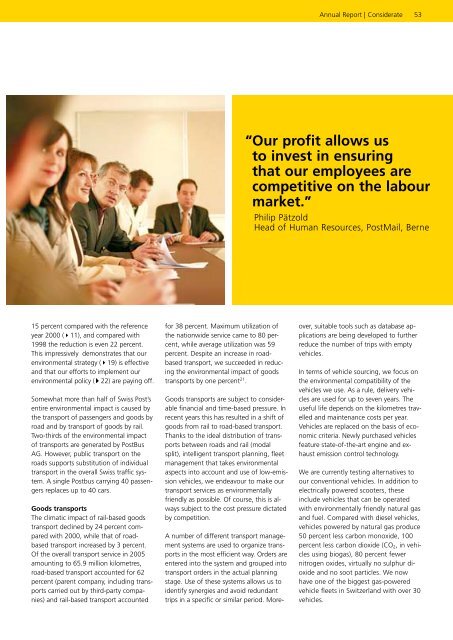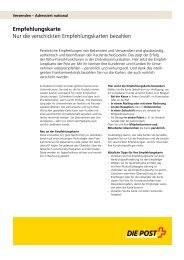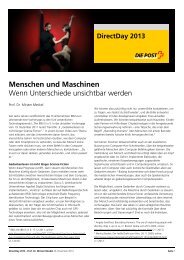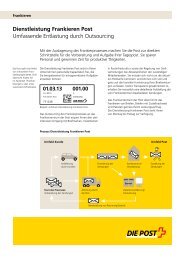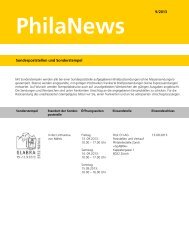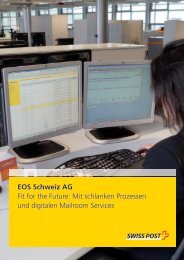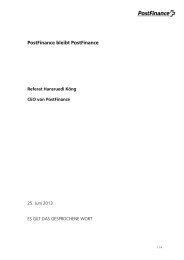Service-oriented - Die Schweizerische Post
Service-oriented - Die Schweizerische Post
Service-oriented - Die Schweizerische Post
Create successful ePaper yourself
Turn your PDF publications into a flip-book with our unique Google optimized e-Paper software.
15 percent compared with the reference<br />
year 2000 ( 11), and compared with<br />
1998 the reduction is even 22 percent.<br />
This impressively demonstrates that our<br />
environmental strategy ( 19) is effective<br />
and that our efforts to implement our<br />
environmental policy ( 22) are paying off.<br />
Somewhat more than half of Swiss <strong>Post</strong>’s<br />
entire environmental impact is caused by<br />
the transport of passengers and goods by<br />
road and by transport of goods by rail.<br />
Two-thirds of the environmental impact<br />
of transports are generated by <strong>Post</strong>Bus<br />
AG. However, public transport on the<br />
roads supports substitution of individual<br />
transport in the overall Swiss traffic system.<br />
A single <strong>Post</strong>bus carrying 40 passengers<br />
replaces up to 40 cars.<br />
Goods transports<br />
The climatic impact of rail-based goods<br />
transport declined by 24 percent compared<br />
with 2000, while that of roadbased<br />
transport increased by 3 percent.<br />
Of the overall transport service in 2005<br />
amounting to 65.9 million kilometres,<br />
road-based transport accounted for 62<br />
percent (parent company, including transports<br />
carried out by third-party companies)<br />
and rail-based transport accounted<br />
for 38 percent. Maximum utilization of<br />
the nationwide service came to 80 percent,<br />
while average utilization was 59<br />
percent. espite an increase in roadbased<br />
transport, we succeeded in reducing<br />
the environmental impact of goods<br />
transports by one percent 21 .<br />
Goods transports are subject to considerable<br />
financial and time-based pressure. In<br />
recent years this has resulted in a shift of<br />
goods from rail to road-based transport.<br />
Thanks to the ideal distribution of transports<br />
between roads and rail (modal<br />
split), intelligent transport planning, fleet<br />
management that takes environmental<br />
aspects into account and use of low-emission<br />
vehicles, we endeavour to make our<br />
transport services as environmentally<br />
friendly as possible. Of course, this is always<br />
subject to the cost pressure dictated<br />
by competition.<br />
A number of different transport management<br />
systems are used to organize transports<br />
in the most efficient way. Orders are<br />
entered into the system and grouped into<br />
transport orders in the actual planning<br />
stage. Use of these systems allows us to<br />
identify synergies and avoid redundant<br />
trips in a specific or similar period. More-<br />
Annual Verantwortungsbewusst<br />
Report | Considerate<br />
53<br />
“ Our profit allows us<br />
to invest in ensuring<br />
that our employees are<br />
competitive on the labour<br />
market.”<br />
Philip Pätzold<br />
Head of Human Resources, <strong>Post</strong>Mail, Berne<br />
over, suitable tools such as database applications<br />
are being developed to further<br />
reduce the number of trips with empty<br />
vehicles.<br />
In terms of vehicle sourcing, we focus on<br />
the environmental compatibility of the<br />
vehicles we use. As a rule, delivery vehicles<br />
are used for up to seven years. The<br />
useful life depends on the kilometres travelled<br />
and maintenance costs per year.<br />
Vehicles are replaced on the basis of economic<br />
criteria. Newly purchased vehicles<br />
feature state-of-the-art engine and exhaust<br />
emission control technology.<br />
We are currently testing alternatives to<br />
our conventional vehicles. In addition to<br />
electrically powered scooters, these<br />
include vehicles that can be operated<br />
with environmentally friendly natural gas<br />
and fuel. Compared with diesel vehicles,<br />
vehicles powered by natural gas produce<br />
50 percent less carbon monoxide, 100<br />
percent less carbon dioxide (CO2, in vehicles<br />
using biogas), 80 percent fewer<br />
nitrogen oxides, virtually no sulphur dioxide<br />
and no soot particles. We now<br />
have one of the biggest gas-powered<br />
vehicle fleets in Switzerland with over 30<br />
vehicles.


